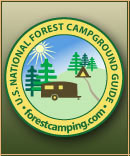Grassland Information
The Lyndon B. Johnson National Grassland (of the Caddo-Lyndon B.
Johnson National Grasslands) is located in central Texas about 43
miles north of Ft. Worth and covers 17,784 acres. There are
three developed campgrounds, two of which meet the selection
criteria.
Lyndon B. Johnson National Grassland (LBJ), of the Caddo-Lyndon
B. Johnson National Grasslands, is the most southernly of the
national grasslands and has a rich history. The land we now call
LBJ was the home of great herds of bison, antelope, deer, and elk
and a favored hunting ground of the Native people. The Caddo
Indians, the largest Indian culture in Northeast Texas, were the
first cultivators of this land. They were forced out around the
mid-1700s by the more aggressive Apache and Comanche people. The
European settlers, primarily stockmen, moved into the area in the
1800s with the farmers following in the early 1900s. The land
has seen great cattle drives, with an estimated ten million head
of cattle driven northward, and the advent of barbed wire.
Cattle, barbed wire, and farming brought major changes to the
land.
The areas now designated as "grasslands" were settled in the
1800s under a variety of "Homestead Acts" that opened the land to
people, generally farmers, and helped to settle the west. A
prolonged period of drought in the late 1920s into the 1930s
caused some homesteads on sub-marginal farmland (a location
receiving 15 or less inches of annual moisture) to literally dry
up and blow away. During this time, Congress established the Land
Utilization Program (LUP) which bought homesteads from bankrupt
private owners and returned it to public land status. The
Civilian Conservation Corps (CCC) helped to stabilize the eroding
soil by re-seeding it and applying other conservation techniques.
In the 1950s, the LUP holdings were assigned to the USDA Forest
Service which was tasked with management of these sub-marginal
lands. Over the years the Forest Service has established some
twenty National Grasslands. "The designation of the area as
National Grassland is not a description of the area as much as a
statement of policy and effort to restore the area to a multiple
of uses and benefits."
Early explorers expected to find wind-swept prairies but instead
found a barrier of timber with dense, heavy undergrowth. This
belt of timber ran north to south across rather than along the
major waterways. Known as the "Cross Timbers," it was a major
landmark of the western prairies. Once called Cross Timbers
National Grassland because of this unique landmark, the LBJ was
renamed in 1974 after the former President. Since that time, the
Forest Service has encouraged the return of the "Cross Timber"
environment while following its mandate "aimed at promoting
better utilization of the land, provide work in the depressed
area, and to develop water oriented recreation facilities."
Oil and gas exploration and development is an ongoing effort.
Wildfire control, prescribed burning, and wildlife management is
used for the healthy recovery of the land. It should be
mentioned the area where the LBJ is located is a transition zone.
This is where the eastern forest becomes tallgrass prairie. The
diversity of the land means 1,100 different plant species are
found within the LBJ boundaries. And hundreds of animals and
birds, dependent on the LBJ diversity and health, make it their
homes.
The LBJ is a bird watchers holiday. The winter is probably the
best time for spotting the greatest variety of our winged friend
but LBJ is on the flight path for Fall migration. For a
comprehensive list, ask for a "Bird Checklist for Wise County,
Texas" at the ranger district office.
Recreation, in its many forms, is a big part of today's LBJ. The
TADRA Point campground is the trailhead to a 75-mile network
which includes five different loop trails that attracts
equestrian enthusiasts from as far away as Amarillo and Ft.
Worth-Dallas metro areas. These trails cover land where once the
Chisholm trail was used to move huge herds of cattle northward
and the Comanche people roamed. Black Creek Lake, with its
adjacent campground and huge oaks, is popular for fishing, as
well as tent camping and boating.
One unique feature of the LBJ can be found at Valley View. Here,
the Forest Service and various bird-dog clubs have developed a
"designated bird dog training area." Here, bird-dogs receive
real-world experience under controlled conditions in trials and
training sessions held throughout the year.
Lyndon B. Johnson National Grassland does more than provide
grazing land for cattle and habitat for wildlife. This
grassland, within an easy drive of Dallas-Ft. Worth and Amarillo
metro areas, offers its visitor a chance to escape the hectic
pace of modern life. Whether exploring the grassland on foot or
atop a horse or mule, landing a prize Largemouth bass, watching a
bird-dog make a perfect point, or just relaxing by a campfire,
the LBJ offers visitors a chance to re-contact with nature. Come
and see for yourself.
ADDRESSES
SUPERVISOR OFFICE
2221 N. Raguet St.
Lufkin, Texas 75904
936-639-8501
RANGER DISTRICT ADDRESS
Caddo-LBJ
1400 US Hwy. 81/287
POB 507
Decatur, Texas 76234
940-627-5475 |
